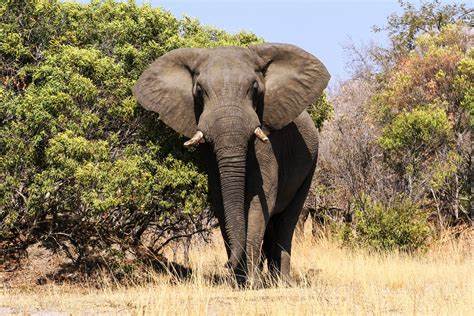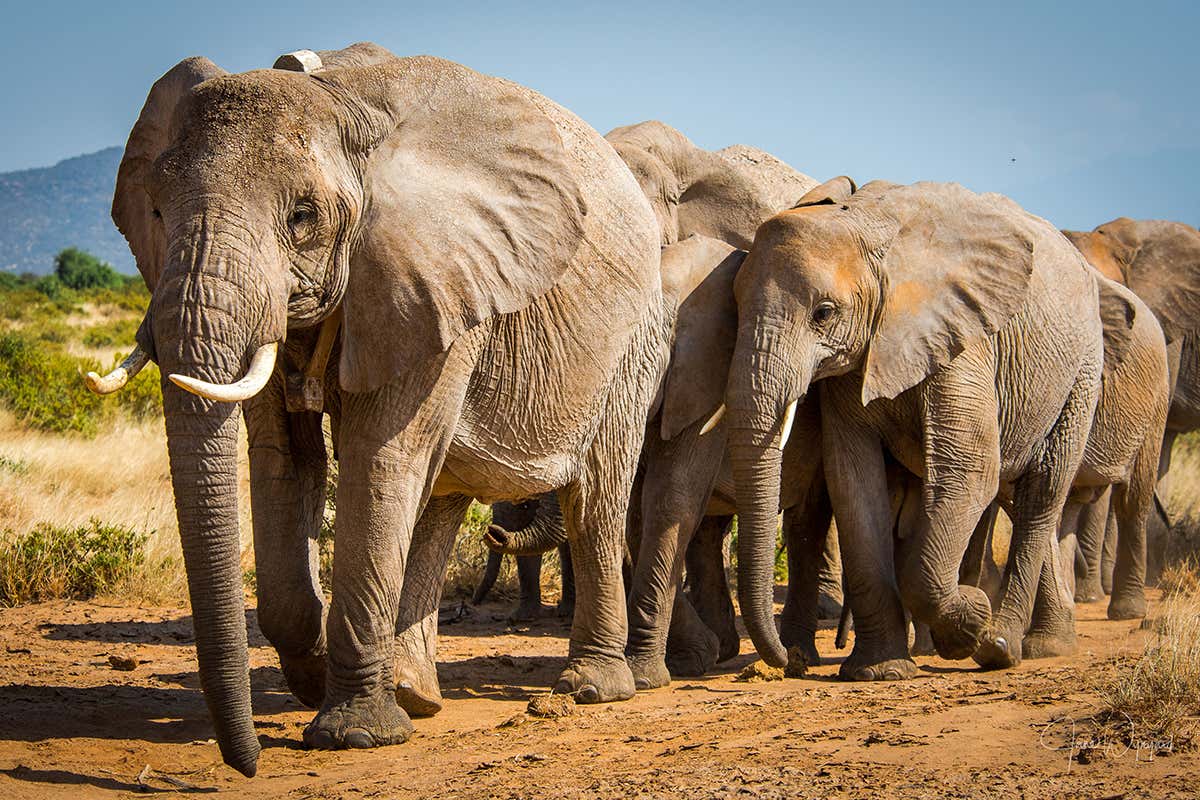One of Uganda’s many natural wonders is the majestic African Elephant. These gentle giants are a highlight for any safari adventure. Unlike Asia, Africa boasts two elephant subspecies, and Uganda is fortunate to be home to one: the African Elephant.
Within this species, Uganda shelters two distinct groups – the social savanna elephant and the elusive forest elephant.

During your Ugandan safari, keep your eyes peeled for the savanna elephant. These larger elephants can be seen in Kidepo Valley, Murchison Falls, and Queen Elizabeth National Parks.
The forest elephant, known for its shyness, is a rarer sight. If you’re looking for a challenge, head to Mgahinga Gorilla Park, Semuliki National Park, Bwindi Impenetrable Forest, or Kibale Forest. Patience and a good guide might just reward you with a glimpse of these remarkable creatures.
Here are some facts about elephants
The elephant’s trunk is an all-purpose tool
An elephant’s trunk isn’t just a nose; it’s a remarkable feature that serves as an all-purpose tool with various functions.
First and foremost, the trunk is essential for survival. It allows elephants to breathe, smell, and grasp food. But its capabilities go far beyond basic needs.
With incredible strength, the trunk can lift enormous weights – up to 700 pounds! This allows them to carry calves, uproot small trees, or break branches for tastier leaves.
However, this strength is balanced by surprising finesse. The tip of the trunk is incredibly sensitive, allowing them to delicately pick up a single blade of grass. It’s like having a built-in weightlifter and a surgeon rolled into one!
The trunk’s versatility doesn’t stop there. It acts as a straw to suck up water, a shovel to dig for hidden sources, and a giant showerhead to cool down on a hot day. Elephants even use their trunks to express affection, gently caressing their young and each other.
The elephant’s trunk is a true testament to nature’s ingenuity. It’s a single body part that embodies incredible strength, delicate touch, and a surprising range of uses, making it the ultimate multi-tool.
Elephants are the largest terrestrial mammal
Elephants, the undisputed kings of the land, dwarf other terrestrial mammals. Their immense size, captured in countless photos and videos, might not surprise you anymore. But just how big are we talking? An adult African elephant stretches 3 to 4 meters long and tips the scales at a staggering 2.25 to 6.5 tons! This incredible bulk likely explains their inability to jump.
Despite their size, elephants boast surprisingly large brains, weighing a hefty 5.4 kilograms. Perhaps this is what it takes to manage such a massive body! To fuel their impressive size, elephants are nature’s ultimate grazers. They spend a whopping 16 hours a day consuming up to 136 kilograms of food. That’s not all – they also guzzle a staggering 30-50 gallons of water daily, drawing in up to 15 liters at a time.
But don’t be fooled by their size – elephants are surprisingly athletic. They can run at impressive speeds of 40 kilometers per hour! And thanks to their amazing trunks, which can act as snorkels, they’re even adept swimmers. These gentle giants truly possess a surprising array of talents hidden beneath their massive frames.
They are intelligent animals
Elephants are more than just impressive size; they’re remarkably intelligent creatures. Their emotional depth is evident in their mourning rituals for deceased family members. They comfort each other with gentle touches of their trunks, demonstrating a capacity for empathy.
Elephants even possess a level of self-awareness rarely seen in the animal kingdom. They’ve been observed recognizing themselves in mirrors, a feat that requires a sophisticated understanding of self.
Their exceptional memory plays a crucial role in their survival. Elephants can recall the location of water sources they encountered years ago, a vital skill in harsh environments. This impressive mental ability allows them to navigate vast landscapes and find the resources they need to thrive.
Elephants have a unique and strong social and family structure
Elephants are incredibly social creatures with a unique family structure called a matriarchy. Females of all ages live together in tight-knit herds, led by the wise and experienced matriarch. This dominant female plays a vital role, guiding the herd to food and water sources and keeping them safe from danger.
The herd typically consists of the matriarch, her daughters, granddaughters, and their young calves. Male elephants, on the other hand, tend to be solitary creatures. They leave the family group once they reach maturity and only rejoin for mating purposes.
This social structure is hierarchical. The matriarch holds the highest position, and her death triggers a natural succession. The eldest daughter usually steps up to assume the leadership role, carrying on the wisdom and experience passed down through generations.
The elephant family exemplifies the power of the maternal bond. Elephants exhibit a strong instinct to care for their young and each other. The matriarch, with her keen awareness of dangers, leads the herd away from threats like fires. In harsh environments, she may even split the family into smaller groups, increasing their chances of finding enough food and water to survive. This remarkable social structure allows elephants to thrive in
Elephants have distinct communication abilities
Elephants boast a complex communication system that goes far beyond simple sounds. They utilize a remarkable combination of vocalizations, body language, and even infrasound – sounds too low for humans to hear. This intricate system has led some to believe elephants possess a secret language.
Their vocalizations are a symphony of information. From low rumbles that travel vast distances to high-pitched trumpets and chirps, each sound conveys a specific message. These messages can range from mundane daily needs, like summoning the herd for water, to crucial social cues like signaling mating readiness.
But sound isn’t their only tool. Elephants are masters of body language. Their vast ears, shaped like the African continent in the case of African elephants, play a dual role. By flapping them, elephants can cool themselves down. However, these impressive ears also function as powerful hearing aids, allowing them to detect calls from fellow elephants miles away.
Elephants’ communication system is a testament to their remarkable intelligence and social complexity. It allows them to maintain strong social bonds, navigate their environment effectively, and even warn each other of potential dangers.
We hope you’ve enjoyed learning about these fascinating creatures. Witnessing elephants in their natural habitat is a truly unforgettable experience, and Uganda offers a prime opportunity for responsible wildlife safaris.
However, elephants face significant threats. While they have no natural predators, human activity poses a major challenge. Poaching for ivory and habitat loss due to human encroachment are the biggest dangers they face.
The good news is that with dedicated conservation efforts, these gentle giants can thrive for another 50 to 70 years. If you’re passionate about elephant conservation, consider celebrating World Elephant Day (August 12th) by supporting reputable organizations or planning a safari to Uganda. Responsible tourism that contributes to conservation efforts can play a crucial role in securing a brighter future for elephants.





https://www.pexels.com/ru-ru/@adriel-thomas-2156050522/
permanent virtual number
аренда яхты на кубе
In my opinion, you are mistaken.
Интеллектуальные онлайн-сервисы для поиска информации становятся всё более востребованными.
Они позволяют изучать публичные данные из интернета.
Такие боты подходят для журналистики.
Они умеют быстро обрабатывать большие объёмы информации.
gods eye tg
Это позволяет сформировать более полную картину событий.
Отдельные системы также предлагают удобные отчёты.
Такие платформы активно применяются среди исследователей.
Совершенствование технологий позволяет сделать поиск информации эффективным и удобным.
Нейросетевые онлайн-сервисы для поиска информации становятся всё более удобными.
Они помогают изучать доступные данные из социальных сетей.
Такие боты подходят для исследований.
Они способны точно обрабатывать большие объёмы данных.
ай оф год
Это способствует сформировать более точную картину событий.
Некоторые системы также предлагают удобные отчёты.
Такие боты широко используются среди исследователей.
Развитие технологий превращает поиск информации более точным и наглядным.
What words… super, remarkable idea
——
cheap car rental amman https://drivelity.com/car-rental-amman-jordan
Yo, VK777 is legit! Been using it for a while now and no complaints. Easy to navigate and the games are pretty sweet. Check it out vk777
https://www.gametracker.com/clan/Dynamickillercs/forum.php?thread=204793
Yo, I’ve been hitting up 79clubac recently! The games are legit, and I appreciate that they have responsible gaming features. It’s good to see they care about their players. Worth a look, for sure! See more: 79clubac
I every time used to read post in news papers but now as I am a user of web so from now I am using net for articles, thanks to web.